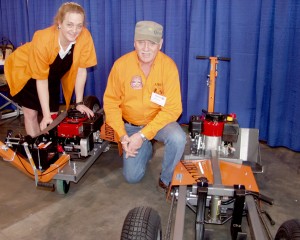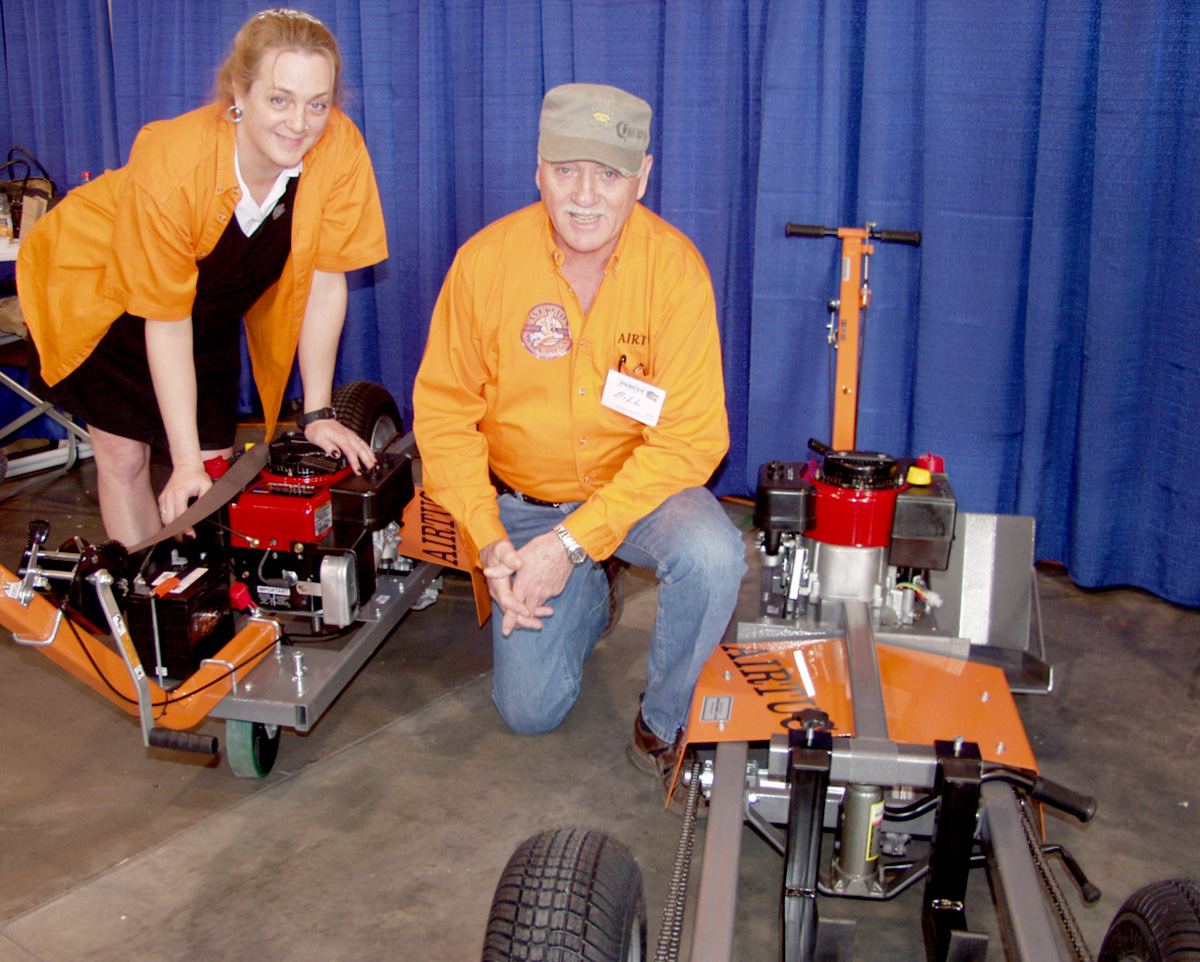
William Anson, creator of Airtug equipment, and his daughter Karen, who now runs the company, displayed their product line of aircraft towing products at the Northwest Aviation Conference and Trade Show, held near Seattle in January.
By Terry Stephens
Light planes, heavy planes, prop planes and executive jets all have at least one thing in common; on the ground, they’re a challenge for their owners or small airport FBOs to muscle around. That’s the problem William Anson faced 33 years ago in Detroit.
“I was younger then, and I could move my Piper Apache around myself,” he said. “But after I did the Bob Hoover thing and got a Twin Commander, I had to build some kind of machine to move it in and out of the hangar. That wound up launching me into the aircraft tug business.”
Using skills he had developed in a variety of manufacturing jobs, including tool-and-die work and boat building, he designed and built a motor-powered tug. Realizing his tug could help others, he set up a business to market his products under the PowerTow brand.
For nearly 33 years, as other aircraft towing products have come on the market, the family-owned business has maintained a share of the global “tug” sales by keeping operating expenses down, providing quality construction and issuing a unique warranty, offering free return shipping if necessary.
From the beginning, Anson worked to keep his business small, limiting production to manageable levels to maintain quality. In the late 1970s, he and his wife moved to Sandpoint, Idaho, where they built a shop and built tugs for a dozen years. When the couple parted ways in the early 1990s, she bought the business and kept the name PowerTow, which still brands her line of aircraft tugs.
“She’s done very well, building the earlier ones I designed and then ones she had engineers design later,” Anson said. “I branched off on my own and built a new line I called Airtugs, built primarily to handle bigger aircraft.”
From Sandpoint, he moved to Ronan Airport in Ronan, Mont., north of Missoula. About four years ago, his daughter took over the business and set up a production shop in Gold Bar, in eastern Snohomish County.
“About 80 percent of our orders come from the United States, and the rest from overseas,” he said. “Karen recently shipped to Afghanistan.”
Anson says the heart of his popular towing products is his hydrostatic transaxle drive system. The tug’s 10-hp Tecumseh four-cycle engine uses a fixed displacement hydraulic motor, which moves gears linked to a differential to turn chain-driven drive wheels. That’s a more expensive power system for moving aircraft, but its advantage is providing a smooth speed that is variable from slow creeping to a fast walk. And, he said, with no gears to shift, no clutch system will wear out.
An exclusive twist-bar handle that controls travel speed, braking, steering and backing from a single point operates the Airtug. New Airtug hydrostats feature a spring-driven return-to-neutral system that ensures neutral starts and prevents creeping when a running tug is temporarily unattended.
Airtugs come in three models: the AT-30 at $3,195; the AT-40 at $3,695; and the new AT-50 at $3,895, which features a hydraulic forklift that raises nose wheels for towing King Airs, Citations, L-39s and other heavier aircraft.
“We’re still not a big volume business,” said Karen Anson, who does most of the product manufacturing herself. “We sell only about 150 a year, because more volume would mean hiring employees and having larger facilities. Dad has always preached an anti-greed philosophy to me. Being small is what works for us as a family and keeps our prices down. There’s no fluff in the business. I think being small produces a superior, high-quality product.”
Most sales come from referrals and from the Internet, but Anson knows it’s hard for people to buy a costly aircraft tug sight unseen.
“We solved that with our 30-day warranty that includes a free return,” she explained. “If it doesn’t work out, we’ll pay for the return shipping. That makes the risk more comfortable for buyers. It works for us, too, because we’ve found we don’t get any of them back once customers have used them.”
She knows many new tugs on the market are designed to handle specific aircraft, so she markets Airtugs for their flexibility in being able to move a variety of planes.
“That’s makes them very versatile for small FBO operators or people who are thinking about changing planes in the future,” she said.
For more information, visit [http://www.airtug.com].











